Bladder Pain Treatment: A Comprehensive Guide
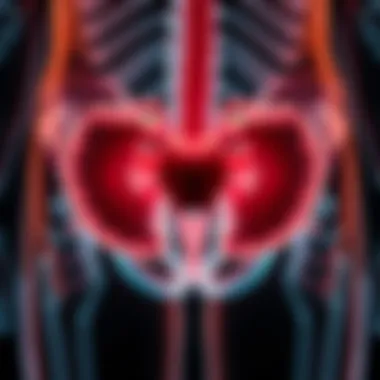
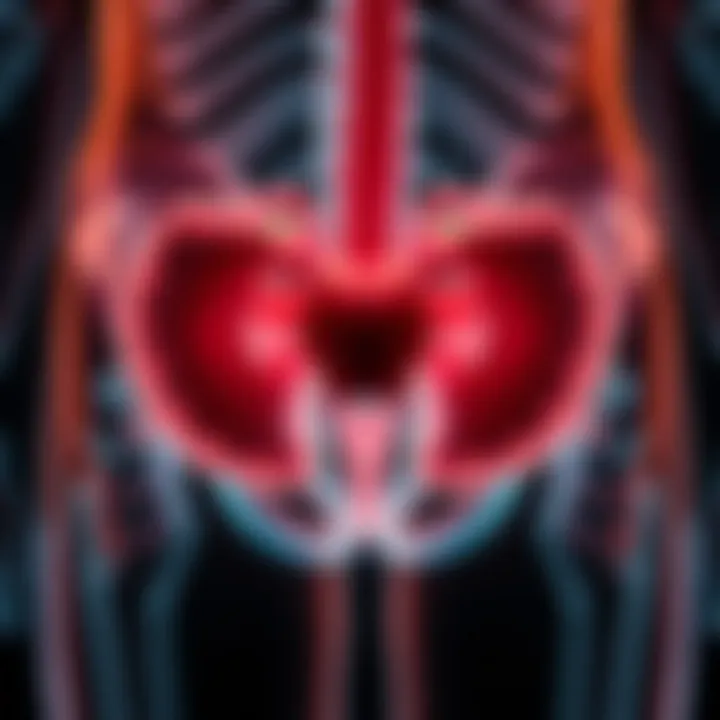
Intro
Bladder pain can be a debilitating experience, impacting one's daily life and overall well-being. Understanding the nature of this type of discomfort is crucial for both patients and healthcare providers. The reasons behind bladder pain are varied and can range from infections to more complex conditions like interstitial cystitis or bladder pain syndrome. This guide is designed to help demystify these origins and present a holistic view of treatment options available today.
It's important to recognize that the experience of bladder pain can differ greatly from one person to another. For some, the pain may come and go, while for others, it can be a persistent issue that leads to feelings of frustration and despair. Identifying the right treatment approach often requires a thorough evaluation and collaboration between patients and their healthcare teams.
With a plethora of treatments available—from traditional medications to cutting-edge therapies—knowing where to start can be daunting. This article not only outlines these treatment modalities but also dives into the underlying causes of bladder pain, the symptoms that accompany it, and the advancements in ongoing research that may enhance future treatment outcomes.
Understanding why bladder pain occurs and how it can be effectively managed can empower patients to take control of their health. As we explore the various aspects of bladder pain treatment, we aim to provide an enriching experience for readers seeking in-depth knowledge on this pressing health matter.
Understanding Bladder Pain
Bladder pain is not just a minor inconvenience; it can significantly alter one's quality of life. Understanding bladder pain requires a comprehensive look at its origins, symptoms, and effective treatments. For patients and healthcare professionals alike, recognizing the breadth of factors contributing to this issue can foster better management strategies. This section serves as a foundational block in the guide, equipping readers with essential insights into bladder pain's anatomy and symptoms, which is crucial before diving into specific treatment options.
Anatomy of the Bladder
The bladder is a muscular sac located in the pelvis, designed to store urine. It possesses an intricate structure lined with a mucosa, which has a unique capability to stretch as it fills up with urine. This flexible design allows for a significant volume of liquid retention, typically around 400-600 milliliters in adults. The bladder wall comprises several layers, including the detrusor muscle that contracts during urination, promoting the expulsion of urine. Understanding the anatomy is vital for recognizing why problems can arise within this organ, leading to pain.
Common Causes of Bladder Pain
Infections
One of the most prevalent culprits of bladder pain is infections, particularly urinary tract infections (UTIs). These infections are typically caused by bacteria that enter the urinary system, leading to inflammation and discomfort. A key characteristic of UTIs is the sudden onset of pain, particularly during urination. They are a common focus in this guide because of their treatability with antibiotics, yet if left untreated, they can escalate into more severe complications. The ease of diagnosis through urinalysis makes it a pivotal point of discussion.
Inflammatory Conditions
Inflammatory conditions of the bladder, such as cystitis, involve swelling and irritation caused by various triggers, including chemical irritants or autoimmune responses. This cause is noteworthy given its chronic nature, often leading to recurring bouts of pain. A hallmark feature of these conditions is that they may not only induce pain but can also contribute to frequent urination. Their chronic nature complicates management, making awareness and diagnosis essential in treatment planning.
Interstitial Cystitis
Interstitial cystitis (IC) is a complex condition marked by chronic pelvic pain and frequent urination without a clear infection. One unique feature that stands out is its unpredictable symptom patterns. Unlike typical UTIs, IC can have flare-ups triggered by certain foods, stress, or hormonal changes. This condition warrants special attention due to its multifaceted management approaches, often requiring a combination of medications and lifestyle changes to alleviate symptoms effectively.
Bladder Tumors
While less common, bladder tumors can also lead to significant bladder pain. These growths can vary widely in nature, from benign to malignant. The key characteristic of bladder tumors is that they often present with other symptoms, such as blood in urine, making it essential to investigate further when such symptoms occur. Their diagnosis through imaging techniques and cystoscopy adds layers of complexity to treatment discussions in the comprehensive understanding of bladder pain.
Symptoms Associated with Bladder Pain
Painful Urination
Painful urination, or dysuria, is typically a hallmark symptom associated with bladder issues. This sensation can range from mild to excruciating depending on the underlying cause. Patients often report a burning sensation that can provoke anxiety about urination. Its significance in the overall context of bladder pain is pronounced, as it can serve as an immediate signal for patients to seek medical advice.
Frequent Urination
Frequent urination, known as polyuria, can occur alongside other symptoms and might indicate an underlying condition, such as UTI or interstitial cystitis. Patients often find this symptom troublesome, as it disrupts daily life and can lead to sleep disturbances. Understanding the reasons behind frequent urination is crucial for managing bladder pain since treating the root problem can significantly reduce its occurrence and improve quality of life.
Pelvic Discomfort
Pelvic discomfort related to bladder issues can be variously described, from a dull ache to intense pressure. This symptom often accompanies other pain symptoms and can complicate the diagnostic process. Patients may struggle to articulate the specific nature of their discomfort, thus complicating effective treatment planning. Recognizing pelvic discomfort as part of the bladder pain experience is fundamental when addressing overall patient care.
Diagnosis of Bladder Pain
Diagnosing bladder pain accurately is a cornerstone of effective treatment. Proper diagnosis not only helps identify the underlying cause of the discomfort but also sets the stage for tailored treatment plans, enhancing patient outcomes. When healthcare professionals embark on the journey to address bladder pain, a systematic approach is paramount. Each element of diagnosis must be carefully considered, as the nuances in presentation can signal vastly different conditions.
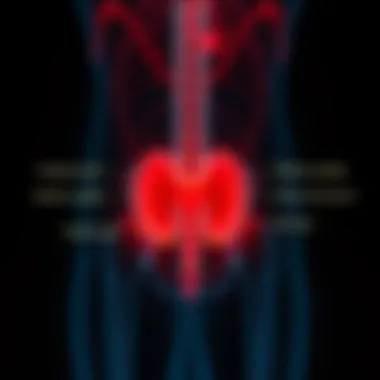
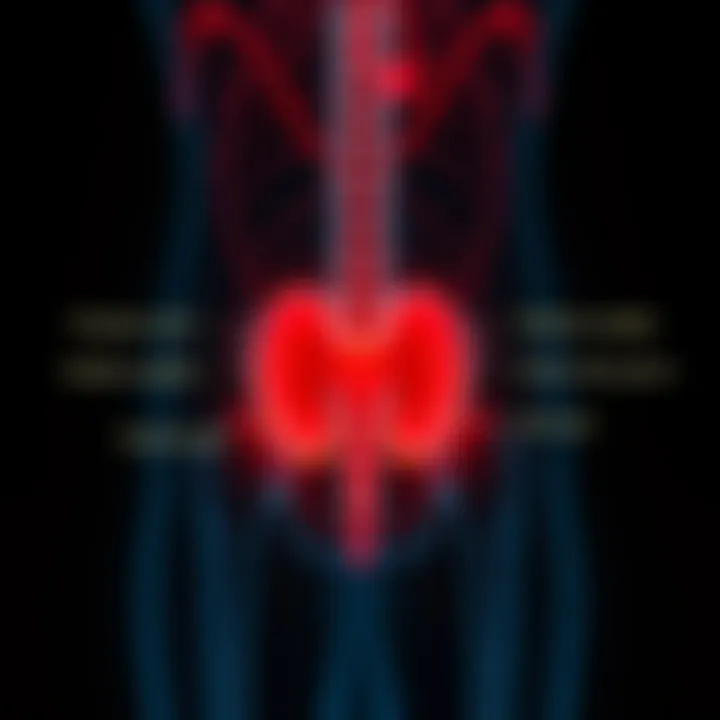
Initial Patient Assessment
Medical History Review
The medical history review is a significant part of assessing bladder pain. It serves as the first factual cornerstone for healthcare providers to understand a patient’s condition. In this step, practitioners delve deep into the patient's previous health issues, any related pain episodes, medications currently in use, and family history. A well-rounded medical history not only spots potential genetic predispositions but also uncovers various factors contributing to bladder pain.
The key characteristic of this review is its focus on the narrative it builds for the healthcare provider. Doing so sheds light on patterns that might not be immediately visible through tests alone. For instance, if a patient frequently reports discomfort after specific activities or during certain times of the month, it might reflect clues about underlying conditions like interstitial cystitis.
The unique feature related to this review is its personalized nature. Each patient’s experience is distinct. However, a disadvantage can be the patient's subjective nature; sometimes, individuals might overlook significant details or misinterpret their own symptoms.
Physical Examination
A thorough physical examination complements the medical history review, as it allows the healthcare provider to observe the patient�’s condition firsthand. This method focuses on palpating the abdomen, examining any signs of pelvic discomfort, and checking for tenderness. Ultimately, it provides a tangible insight into the state of the bladder and surrounding structures.
The key characteristic of a physical examination is its hands-on approach. This method can sometimes reveal abnormalities that the patient may have overlooked, such as palpable masses or areas of inflammation.
What sets this examination apart is how it taps into the clinical skills of the provider. Inexperienced practitioners may find it challenging to diagnose subtle signs, which can lead to misinterpretations or missed diagnoses. Thus, the quality of this process can significantly influence the accuracy of the subsequent diagnostic pathway.
Diagnostic Tests
Urinalysis
Urinalysis is a foundational diagnostic test that explores the composition of urine. This test can uncover various underlying conditions that may lead to bladder pain, such as infections or the presence of blood (hematuria). As a preliminary approach, it's non-invasive and often yields immediate information that can guide further investigation.
Its significant feature lies in its broad spectrum of utility; it can help diagnose infections, kidney issues, and even metabolic disorders. Considering the patient experience, urinalysis is usually low-stress and straightforward, making it a popular choice for initial assessments. However, the limitation is that it may not always provide definitive answers, especially in cases of interstitial cystitis or specific chronic conditions.
Cystoscopy
Cystoscopy stands out among diagnostic tests as it allows direct visualization of the bladder and urethra using a camera. This test is particularly beneficial for cases where other tests have not provided clear answers. By enabling the healthcare provider to detect abnormalities directly, such as tumors, stones, or inflammation, cystoscopy offers a level of precision that is unmatched.
The key characteristic is its visual exploration capability. This method can confirm diagnoses that other tests may only suggest, thus saving time and providing clarity to treatment strategies. On the flip side, cystoscopy often requires some sedation, and there’s a slight risk of complications such as infection, which may deter some patients from undergoing this procedure.
Imaging Techniques
Imaging techniques, including ultrasounds and CT scans, play an essential role in diagnosing bladder-related issues. These tests provide deeper insights into the anatomical structure of the bladder and surrounding areas, facilitating the identification of any structural abnormalities or pathologies. Utilizing these images helps healthcare providers gather a complete picture, which is particularly invaluable in complex cases.
The hallmark of imaging techniques is their ability to unveil hidden matters that might not be apparent through other assessments. For instance, a CT scan might reveal a tumor or anatomical anomalies that could be contributing to symptoms. However, these methods can pose a disadvantage in terms of accessibility and cost, leaving some patients with limited options for comprehensive evaluations.
By integrating these various diagnostic components, healthcare professionals pave the way for effective treatment, enhancing the understanding of bladder pain and its implications. As such, a well-rounded approach to diagnosis is vital, encouraging informed decisions and personalized care for those suffering from this complex issue.
Conventional Treatment Approaches
Conventional treatment approaches play a crucial role in the management of bladder pain. Understanding these methods provides patients and healthcare professionals with a solid foundation to develop effective treatment plans. The significance of conventional treatments lies not just in their application but also in their ability to address immediate symptoms, thereby enhancing the quality of life for individuals suffering from this often-debilitating condition.
Medications
Antibiotics for Infections
Antibiotics are a staple in the treatment of bladder infections, which are among the common contributors to bladder pain. One of the primary characteristics of antibiotics is their ability to effectively eliminate bacterial infections within the urinary tract. In this article, the highlight on antibiotics stems from their popularity and efficacy as a first line of defense. The unique feature of antibiotics is their targeted function against specific bacteria, which helps clear the infection swiftly. However, it’s crucial to be aware of their disadvantages: overuse can lead to antibiotic resistance, posing a challenge down the line for treatment of more severe infections.
Antidepressants for Pain Management
Antidepressants have gained attention in the realm of bladder pain management due to their unique mechanisms that extend beyond mood improvement. Particularly, certain types of antidepressants, like amitriptyline, serve dual purposes; while they lift mood, they also help manage chronic pain signals sent to the brain. This feature makes antidepressants a beneficial option for patients whose pain is linked to psychological factors as well as direct bladder issues. A downside, though, can be the side effects such as weight gain or fatigue, leading some patients to abandon the treatment altogether.


Antispasmodics
Antispasmodics come into play when addressing bladder spasms, which can lead to heightened pain and discomfort. This class of medication works by relaxing the bladder muscles, providing relief from painful contractions. Antispasmodics are valued for their rapid action and their ability to diminish discomfort during acute episodes of pain. Still, one needs to consider possible side effects like dry mouth or constipation, which can deter some patients from consistent use.
Physical Therapies
Pelvic Floor Physical Therapy
Pelvic floor physical therapy is a method gaining ground in treating bladder pain, which focuses on the muscles that support the bladder. The essential characteristic of this therapy is its hands-on techniques that help alleviate pain and improve bladder function. It has become a popular choice because it offers a non-invasive way to manage symptoms. Patients often report significant improvements in their ability to control urination and reductions in pain levels. However, the effectiveness can vary from person to person, and some may need to commit to a longer therapy duration to see results.
Biofeedback Techniques
Biofeedback techniques are increasingly being acknowledged for their role in bladder pain treatment. This approach empowers patients by teaching them how to control certain bodily functions, specifically related to the pelvic floor, using real-time feedback. The defining aspect of biofeedback is its personalized nature; each session can be tailored to an individual’s needs, making it a potentially beneficial choice. However, patients should be prepared for a learning curve, as mastering the techniques may take time and patience.
"Medications and physical therapies combined provide a multifaceted approach for effectively treating bladder pain, enhancing patients' overall well-being."
Conventional treatment approaches encompass an array of strategies, each holding its unique value and relevance in managing bladder pain. While medications offer immediate relief, physical therapies provide long-term solutions. Understanding these treatments, their strengths, and their limitations allows for a comprehensive approach tailored to individual patient needs.
Alternative and Complementary Treatments
The realm of bladder pain management often transcends traditional medical approaches, leading patients and healthcare providers alike to consider alternative and complementary treatments. These strategies may offer promising pathways for symptom relief and overall wellness, which regular methods might not fully address. In navigating the multifaceted nature of bladder pain, exploring these options can be essential, especially when conventional treatments yield insufficient relief.
Dietary Adjustments
Food choices hold significant sway on bodily functions, including bladder health. Individuals suffering from bladder pain may find relief through dietary adjustments that identify and eliminate irritants. Certain foods and drinks can exacerbate pain, such as caffeine, alcohol, spicy meals, and acidic fruits. Conversely, embracing a diet rich in fiber, whole grains, and vegetables can help maintain regularity and support a healthy bladder.
"Put your best foot forward; a well-balanced diet can lead to improved symptoms and better management of bladder pain."
Some strategies to consider include:
- Keep a food diary to identify triggers.
- Increase hydration while avoiding irritants.
- Incorporate anti-inflammatory foods like turmeric and ginger.
These changes might not work overnight, but even subtle shifts can lead to substantial improvements over time.
Herbal Remedies
Herbal treatments have been part of medicinal practices across cultures for centuries, and bladder pain relief is no exception. Certain herbs may provide anti-inflammatory and soothing properties that can be beneficial. Some options include:
- Cornsilk: Often used as a remedy for urinary issues, it may help in calming inflammation.
- Marshmallow root: Known for its mucilaginous properties, it may soothe the bladder lining.
- Cranberry extract: Recognized for its potential to prevent urinary infections, it plays an important role in bladder health.
While these remedies appear promising, they must be approached with caution. Always consult a healthcare professional before introducing any new herbal products, as interactions with prescribed medications can occur.
Acupuncture and Mind-Body Techniques
Acupuncture, a practice grounded in traditional Chinese medicine, involves inserting thin needles into specific body points. This technique aims to restore energy balance while also alleviating pain. Research has indicated that acupuncture may reduce bladder pain symptoms by influencing the body’s nervous system, increasing blood flow and promoting relaxation.
Mind-body techniques, such as yoga and meditation, can also play a pivotal role in bladder pain management. Stress often exacerbates symptoms; thus, integrating relaxation practices can foster a sense of calm, thereby potentially reducing feelings of discomfort.
Benefits include:
- Enhanced pain relief through relaxation and tension release.
- Improved emotional well-being, which can have a positive impact on overall symptom management.
- Increased body awareness, often leading to better self-care practices.
Combining these techniques with conventional treatments might ultimately lead to a more comprehensive management plan.
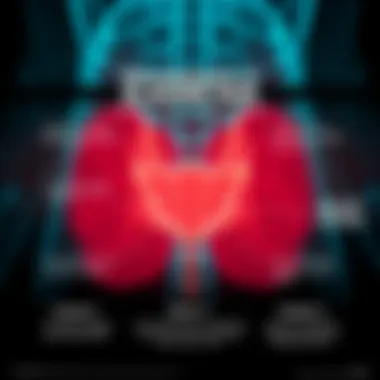
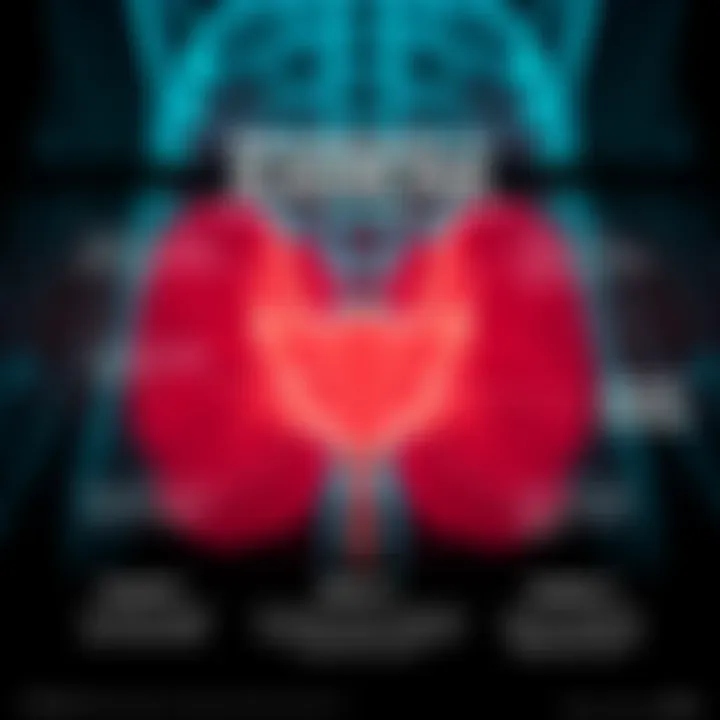
In summary, alternative and complementary treatments for bladder pain, such as dietary adjustments, herbal remedies, and acupuncture can enrich a patient's coping arsenal. Though these methods may not replace conventional treatments, they hold the potential to enhance overall quality of life. As always, it's crucial for individuals to consult healthcare professionals before venturing down new paths in their treatment journey.
Ongoing Research and Future Directions
The landscape of bladder pain treatment is evolving at a rapid pace, with ongoing research igniting hope for enhanced management strategies. This section highlights the significance of research—a critical component in uncovering innovative solutions and refining existing practices. Understanding the complexities of bladder pain requires a mixture of ingenuity and analytical thinking, prompting investigation into the mechanisms underlying this often debilitating condition. The shifts in treatment approaches, driven by empirical evidence, promise to offer patients personalized care that aligns closely with their unique experiences and symptoms.
Clinical Trials and New Treatments
Clinical trials serve as the backbone for developing cutting-edge treatments for bladder pain. They allow researchers to rigorously test new medications, therapies, and management strategies. Conducting these trials not only provides valuable data but also reflects the healthcare community's commitment to finding solutions that improve quality of life for patients.
For instance, recent trials have explored the efficacy of drug combinations that target multiple pathways involved in bladder pain. These trials also delve into the potential of regenerative medicine approaches, such as stem cell therapy, which might offer a transformative path to healing damaged bladder tissue. Participating in these studies often provides patients access to novel treatments before they become widely available, which could be a game-changer for those suffering from chronic conditions.
Furthermore, these clinical trials undergo strict ethical oversight, ensuring that participant safety is paramount. As the trials yield results, they contribute to a growing body of evidence that shapes future guidelines and practices, paving the way for an era of more informed and effective treatment modalities.
Emerging Understanding of Bladder Pain Mechanisms
An emerging area of interest within bladder pain research is understanding the biological mechanisms that underpin this condition. Advanced imaging techniques and biomarkers are now being utilized to offer deeper insights into how bladder pain manifests and persists in various populations. Recognizing this complexity can lead to targeted therapies that address the root causes rather than merely alleviating symptoms.
Recent studies have focused on how the nervous system interacts with bladder function. This research has revealed that neuropathic pain signaling could play a role in conditions like interstitial cystitis. Moreover, new hypotheses are being tested around how inflammatory processes and gut microbiota might influence bladder health.
This new knowledge is crucial—not just for clinical applications, but also for educating patients. As healthcare providers gain a clearer picture of what triggers and sustains bladder pain, they can offer more precise recommendations to their patients. This collaborative understanding bridges the gap between patients and providers, fostering a proactive approach in managing bladder pain.
In summary, the ongoing research into bladder pain is vital for unveiling new, effective treatments and improving patient outcomes. Clinical trials are the proving ground for these innovations, while a better grasp of the underlying mechanisms offers the promise of tailored therapies grounded in scientific understanding.
Coping Strategies for Patients
Managing bladder pain can feel like navigating a maze without a map. This is where coping strategies come into play, serving as essential tools for individuals facing this often debilitating condition. It’s not just about finding a remedy; it’s about forging a path to a more comfortable life. Employing various coping mechanisms can enhance patients' overall well-being, providing them with a sense of control over their situation.
Finding Support Networks
Finding a strong support network can make all the difference. Such groups provide not only emotional support but also practical advice. Joining communities, whether online forums or local support groups, lets patients share experiences and strategies that have worked for them. Many find comfort in knowing that they are not alone in their journey.
Additionally, support networks can link patients to healthcare professionals who specialize in bladder pain and related conditions, fostering a holistic approach to care. Here are some ideas for establishing connections:
- Online Communities: Websites like Reddit and specialized forums can offer access to a wealth of information and shared experiences.
- Local Support Groups: Many hospitals or health organizations host meet-ups where patients can connect.
- Social Media Groups: Platforms such as Facebook have dedicated pages for bladder pain support, where members provide tips and encouragement.
Lifestyle Modifications
Lifestyle changes can be a game-changer when managing bladder pain. Small adjustments, from dietary changes to the way one interacts with stress, can compound into significant improvements in quality of life.
Stress Management Techniques
Stress plays a pivotal role in exacerbating bladder pain, making effective stress management essential. Techniques such as meditation, deep breathing exercises, and yoga have shown positive effects. These strategies not only help in relaxation but also aid in lowering the perception of pain. Perhaps the most distinctive characteristic of these techniques is their focus on the mind-body connection, allowing individuals to approach pain management holistically.
- Meditation: Taking a few minutes each day to meditate can help create a sense of calm, reducing stress.
- Breathing Exercises: Practicing controlled breathing can minimize anxiety and promote relaxation.
- Yoga: Various yoga postures can alleviate tension and improve flexibility, promoting overall well-being.
One unique feature of stress management techniques is their accessibility. They require minimal resources and can often be performed anywhere, which is advantageous for many patients. However, not all techniques suit everyone; some may find yoga beneficial, while others may prefer quiet meditation.
Exercise Recommendations
Incorporating appropriate physical activity plays a significant role in managing bladder pain. Exercise can improve physical strength and stamina while also releasing endorphins, the body's natural painkillers. A major characteristic of exercise recommendations is their versatility; whether it’s brisk walking, swimming, or cycling, there are options for varying fitness levels.
- Aerobic Exercise: Gentle aerobic activities can improve blood flow and help manage anxiety, which may correlate with bladder pain.
- Strength Training: Building core strength can provide better support for pelvic health.
- Stretching: Regular stretching can enhance flexibility and relieve muscle tension.
The unique advantage of exercise lies in its dual benefits: it aids both physical health and emotional well-being. On the flip side, those with severe pain may have difficulty starting or maintaining an exercise regimen. Consultation with healthcare providers before beginning any program is advisable.
"In pain management, knowledge is power; understanding your body and what works for you is half the battle."
Ultimately, coping strategies for patients dealing with bladder pain intertwine emotional resilience and practical adjustments, fostering a patient-centric approach to management. By empowering individuals through support systems and lifestyle adaptations, patients can pave the way toward a more manageable, peaceful existence.















